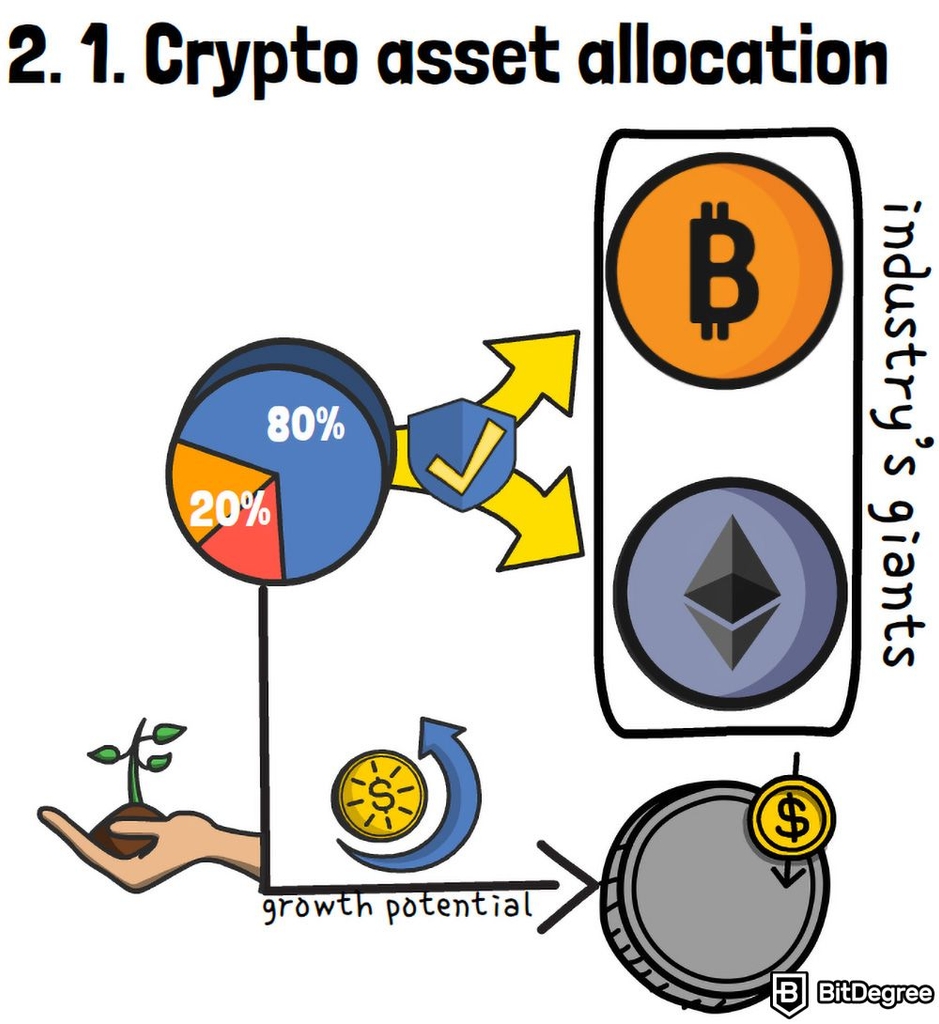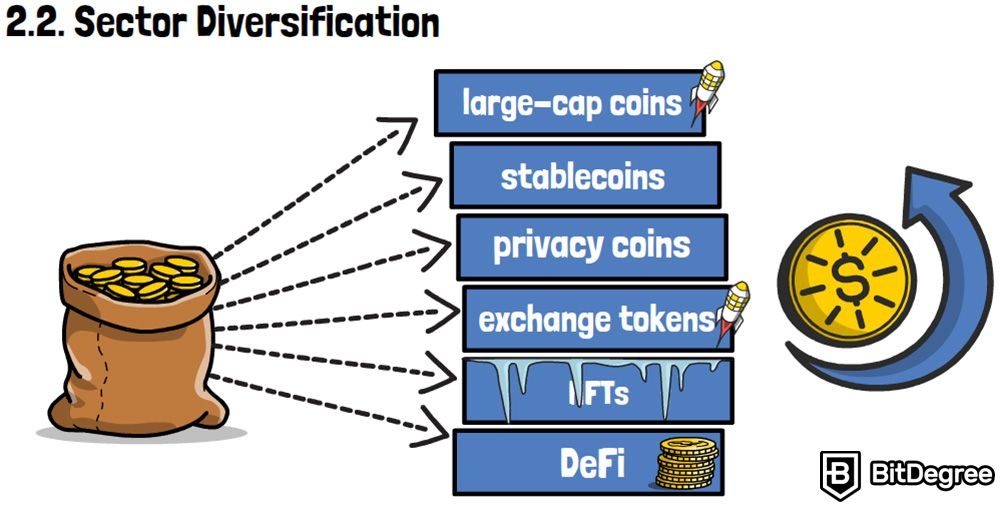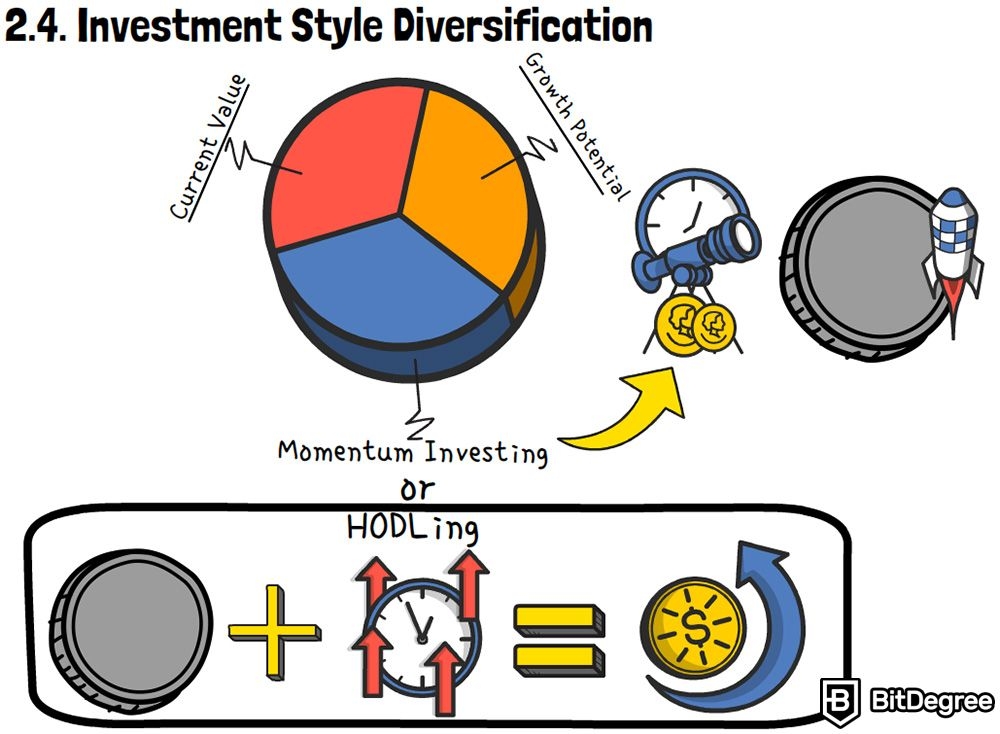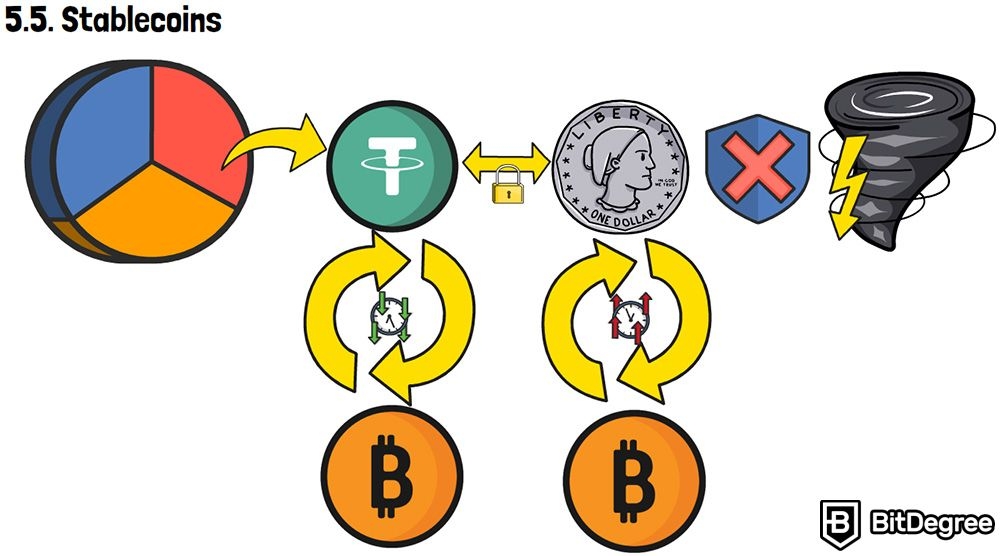Portfolio Diversification: The Whats, the Whys, and the Hows
In this section, we’re going to look into the portfolio diversification definition and why is diversification important in an investment portfolio!
Portfolio diversification and its techniques are among the most important skills that every trader should aim to acquire. Crypto trading is almost synonymous with “risky”, and it’s exactly why portfolio diversification is so important. It reduces the risk.
Despite its obvious importance, portfolio diversification often gets overlooked, especially by beginners. You see, acting cautiously and calculating your moves is not something that goes viral. Therefore, after having spent some time online in crypto spaces, a beginner may reach a conclusion that it’s not that important. And that would be a big mistake!
In this section, we’re going to outline the portfolio diversification definition, take a look at 5 portfolio diversification techniques, and answer the questions of why diversification is important in an investment portfolio. After all, the primary purpose of portfolio diversification is to make safer, more thoughtful investments, and step up your trading game!
Let’s get to it!

Video Explainer
Video Explainer: Portfolio Diversification: The Whats, the Whys, and the Hows
Reading is not your thing? Watch the "Portfolio Diversification: The Whats, the Whys, and the Hows" video explainer
5 Best Crypto Portfolio Diversification Strategies (Animated Explanation)


Portfolio Diversification Definition
Let’s kick this section off by taking a look at the portfolio diversification definition.
At its very core, portfolio diversification is a risk management strategy. Those who practice this strategy spread investments across a variety of assets, and, by doing so, they reduce the overall risk that comes with investing.
The risk is reduced by investing in different types of assets that are not closely related. If one of the investments flop, the others still have the chance to remain afloat, or, even better - generate gains that would counterbalance the losses from the previous, failed investment.
The wisdom of the proverbial saying of "not putting all your eggs in one basket," represents the idea behind portfolio diversification perfectly. But here, let’s consider a more contemporary, yet precise example.
Imagine traveling to a foreign country. Now, would you keep all of your essential belongings, such as your passport, credit cards, and cash in one place, like your backpack? In case of it being stolen, you’re about to have a really bad time.
Therefore, the right thing to do here would be to diversify your traveling portfolio, and spread your valuable belongings across a variety of different places. Such as, your wallet, a fanny pack, or even the safe back at the hotel.

Of course, crypto is a relatively new industry, and portfolio diversification in this space looks a little bit different than it does in the traditional sense. Typically, this strategy means spreading your investments across various asset types such as stocks, bonds, real estate, and cash.
Now, when it comes to crypto, the same principles apply, they just take up a different form. In the crypto space, portfolio diversification is applied by not ignoring the fact that there are many different cryptocurrencies.
Therefore, investing in various coins, such as Bitcoin, Ethereum, and many others, mitigates the risk that comes from tying your financial well-being to one, single cryptocurrency.
Consider a real-life example. Back in 2022, those who had invested the majority of their savings into the FTX token went through a rather harsh life lesson. As the news broke out about FTX, the crypto exchange platform, having financial problems, the exchange’s native token took a nosedive, and never recovered.
On November 8, 2022, the FTX Token was still being sold for over $22. Two days later, its price was just a little bit over $2.
So, people who had unreasonable amounts of money invested in this one particular token, saw a tenfold reduction in their portfolio’s size. However, those who had invested in the FTX Token, but it was only a part of their diversified portfolio, didn’t face the end of their careers as crypto investors.
This story perfectly encapsulates that the primary purpose of portfolio diversification is to mitigate risks that, unfortunately, are all over the place when it comes to crypto.
So, having said that, I could safely state that the portfolio diversification definition includes neutralizing the threats that come from the fact that the cryptocurrency market is so volatile and unpredictable.
Of course, portfolio diversification is not a solution to all the crypto world’s problems. Sometimes, even the most sophisticated diversification solutions couldn’t help the investors avoid losses.
Sometimes, the entire industry will just take a hit, and every coin will turn red. But, even in cases like this, a diversified portfolio provides more stability and less risk than going all in on a single cryptocurrency.
Okay, having said that, we can move on from the theory, and get more practical. Let’s take a look at actual ways of how portfolio diversification can be done. Let’s consider 5 portfolio diversification techniques.
Crypto Portfolio Diversification Techniques
When it comes to "not putting all your eggs in one basket," there are numerous ways of doing that. The same applies to crypto portfolio diversification techniques. Despite their differences, these techniques help traders achieve a balanced allocation of their assets, and reduce the risk that’s inherent in crypto.
Crypto Asset Allocation
The first one is the most self-explanatory. It’s a technique of allocating assets by simply doing exactly that - allocating your crypto assets. Instead of one cryptocurrency, you choose several. You select the coins of your choice, based on their market capitalization, price, community, the coin’s potential, and other similar, equally- important factors.

Of course, many would agree that the safest way is to invest in the industry’s most-established cryptos, such as Bitcoin or Ethereum. Investing in both of them, instead of a single one, would be a step toward the direction of portfolio diversification.
Yet, in addition to that, traders consider investing in other, less-established coins. These coins are cheaper, probably more volatile, and they have a smaller market cap.
Yet they’ve got something else - growth potential. By diversifying your portfolio and allocating a portion of your funds to coins like this, you expect higher returns, and, while having part of your money invested in the industry’s giants, you’d end up balancing the risk that comes from investing in smaller coins.
This technique is often followed by the 80/20 rule. It simply means that 80% of your investments should be aimed at large-cap coins, while the remaining 20% at mid & low-cap coins. By allocating such percentages, traders minimize the risk, but continue taking chances to see those smaller coins shoot into the sky.
Sector Diversification
The second technique is known as Sector Diversification. As its name suggests, it involves investing your crypto in different sectors. So, instead of simply investing into coins, based on their price and market cap, you get more specific.

For example, in addition to the large-cap coins, you invest into stablecoins, privacy coins, exchange tokens, NFTs, or in the DeFi sector as such, by, for example, becoming a staker.
Such a technique allows investors to further reduce the risk that comes with crypto investing. For example, if the NFT market would suddenly freeze, and people would lose interest in acquiring new NFTs, those traders who diversified their portfolios among different sectors would avoid a crisis.
Geographical Diversification
Up next, we’ve got Geographical Diversification. Once again, the name says it all. This technique is all about taking into account one more factor: which region does the coin or token originate from. Despite crypto’s global nature, each coin is issued in a different country, which means that the coin’s issuer is subject to their country’s national legislation.

So, imagine you invest into a crypto of your choice. It looks promising, with high potential, and it seems that there’s not much to worry about. And then, out of nowhere, news broke out that the government has banned crypto in a particular country, and so it happened that this coin of your choice was issued exactly there.
Suddenly, regulatory challenges become a strong obstacle that messes up the seemingly apolitical market dynamics. Therefore, a considerate approach, and the evaluation of the geographical aspect while choosing where to invest are what make the geographical diversification technique useful.
Investment Style Diversification
Moving on, let’s talk about the Investment Style Diversification. This technique is a bit more advanced, since it requires traders to understand the differences between different investment styles.

For example, traders can allocate part of their investments into assets based on their current value, and the other part into assets based on their growth potential, while always actively participating in the so-called Momentum Investing. This means that they have to constantly be on the hunt for signals that could help identify which assets may go through a sudden upward price momentum.
Others may simply not have time for this. Therefore, they could include HODLing in their investment style mix. Simply obtaining and holding particular assets with the hopes that it will pay off in the long run, while continuously obtaining other assets based on their value, growth, and so on.
Asset Allocation into Stablecoins
Last, but not least, we’ve got the most traditional technique of portfolio diversification. This means that it involves the active allocation of your assets into coins that are connected to traditional fiat currencies. I’m talking about stablecoins. This technique allows traders to keep a distance from the volatility storms that are always present in the crypto market.

A trader that invests in stablecoins does not expect them to generate a return, because, obviously, stablecoins have a fixed price. Yet, owning stablecoins creates an opportunity to quickly jump into the crypto market whenever a great opportunity presents itself.
This technique allows traders to save time, since swapping stablecoins for other cryptocurrencies is a faster process than going through the entire procedure of buying them with fiat money.
By the way, if you feel like your knowledge about stablecoins could need some upgrading, make sure to check out my channel - there's a section about this topic, specifically!
Wrapping Up
Having said that, we arrive at the end of this section. I hope that, by now, you’ve got a better understanding of the portfolio diversification definition, and why is diversification important in an investment portfolio, to begin with.
As the crypto industry evolves, the ways and techniques of diversifying your assets will, eventually, change as well, but until then, these methods that I’ve presented today, are among the most popular, trusted and practiced in the industry.















